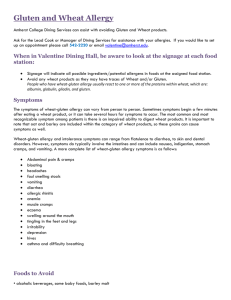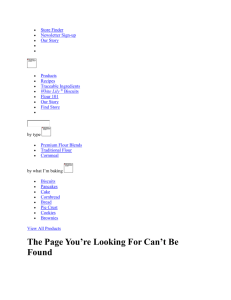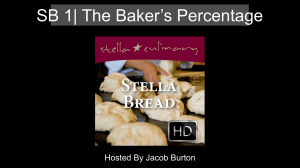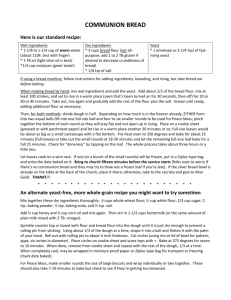Advance Journal of Food Science and Technology 3(6): 413-417, 2011
advertisement
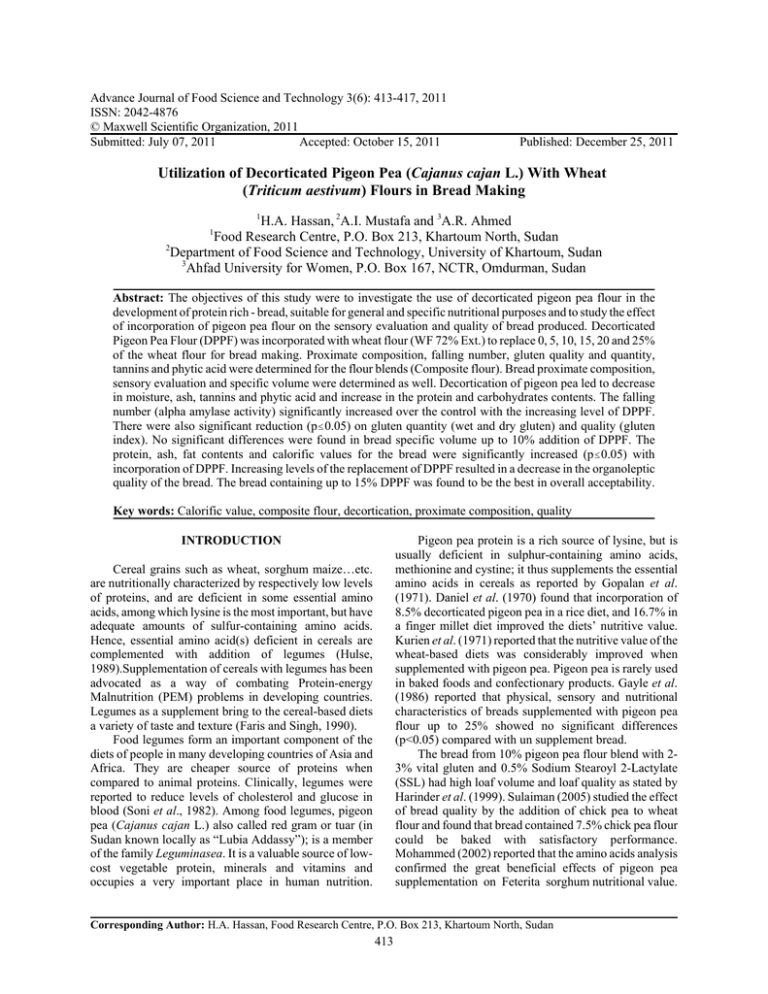
Advance Journal of Food Science and Technology 3(6): 413-417, 2011 ISSN: 2042-4876 © Maxwell Scientific Organization, 2011 Submitted: July 07, 2011 Accepted: October 15, 2011 Published: December 25, 2011 Utilization of Decorticated Pigeon Pea (Cajanus cajan L.) With Wheat (Triticum aestivum) Flours in Bread Making 1 H.A. Hassan, 2A.I. Mustafa and 3A.R. Ahmed Food Research Centre, P.O. Box 213, Khartoum North, Sudan 2 Department of Food Science and Technology, University of Khartoum, Sudan 3 Ahfad University for Women, P.O. Box 167, NCTR, Omdurman, Sudan 1 Abstract: The objectives of this study were to investigate the use of decorticated pigeon pea flour in the development of protein rich - bread, suitable for general and specific nutritional purposes and to study the effect of incorporation of pigeon pea flour on the sensory evaluation and quality of bread produced. Decorticated Pigeon Pea Flour (DPPF) was incorporated with wheat flour (WF 72% Ext.) to replace 0, 5, 10, 15, 20 and 25% of the wheat flour for bread making. Proximate composition, falling number, gluten quality and quantity, tannins and phytic acid were determined for the flour blends (Composite flour). Bread proximate composition, sensory evaluation and specific volume were determined as well. Decortication of pigeon pea led to decrease in moisture, ash, tannins and phytic acid and increase in the protein and carbohydrates contents. The falling number (alpha amylase activity) significantly increased over the control with the increasing level of DPPF. There were also significant reduction (p#0.05) on gluten quantity (wet and dry gluten) and quality (gluten index). No significant differences were found in bread specific volume up to 10% addition of DPPF. The protein, ash, fat contents and calorific values for the bread were significantly increased (p#0.05) with incorporation of DPPF. Increasing levels of the replacement of DPPF resulted in a decrease in the organoleptic quality of the bread. The bread containing up to 15% DPPF was found to be the best in overall acceptability. Key words: Calorific value, composite flour, decortication, proximate composition, quality INTRODUCTION Pigeon pea protein is a rich source of lysine, but is usually deficient in sulphur-containing amino acids, methionine and cystine; it thus supplements the essential amino acids in cereals as reported by Gopalan et al. (1971). Daniel et al. (1970) found that incorporation of 8.5% decorticated pigeon pea in a rice diet, and 16.7% in a finger millet diet improved the diets’ nutritive value. Kurien et al. (1971) reported that the nutritive value of the wheat-based diets was considerably improved when supplemented with pigeon pea. Pigeon pea is rarely used in baked foods and confectionary products. Gayle et al. (1986) reported that physical, sensory and nutritional characteristics of breads supplemented with pigeon pea flour up to 25% showed no significant differences (p<0.05) compared with un supplement bread. The bread from 10% pigeon pea flour blend with 23% vital gluten and 0.5% Sodium Stearoyl 2-Lactylate (SSL) had high loaf volume and loaf quality as stated by Harinder et al. (1999). Sulaiman (2005) studied the effect of bread quality by the addition of chick pea to wheat flour and found that bread contained 7.5% chick pea flour could be baked with satisfactory performance. Mohammed (2002) reported that the amino acids analysis confirmed the great beneficial effects of pigeon pea supplementation on Feterita sorghum nutritional value. Cereal grains such as wheat, sorghum maize…etc. are nutritionally characterized by respectively low levels of proteins, and are deficient in some essential amino acids, among which lysine is the most important, but have adequate amounts of sulfur-containing amino acids. Hence, essential amino acid(s) deficient in cereals are complemented with addition of legumes (Hulse, 1989).Supplementation of cereals with legumes has been advocated as a way of combating Protein-energy Malnutrition (PEM) problems in developing countries. Legumes as a supplement bring to the cereal-based diets a variety of taste and texture (Faris and Singh, 1990). Food legumes form an important component of the diets of people in many developing countries of Asia and Africa. They are cheaper source of proteins when compared to animal proteins. Clinically, legumes were reported to reduce levels of cholesterol and glucose in blood (Soni et al., 1982). Among food legumes, pigeon pea (Cajanus cajan L.) also called red gram or tuar (in Sudan known locally as “Lubia Addassy”); is a member of the family Leguminasea. It is a valuable source of lowcost vegetable protein, minerals and vitamins and occupies a very important place in human nutrition. Corresponding Author: H.A. Hassan, Food Research Centre, P.O. Box 213, Khartoum North, Sudan 413 Adv. J. Food Sci. Technol., 3(6): 413-417, 2011 Table 1: Proximate composition and anti-nutritional factors of wheat and pigeon pea flours (on dry matter basis) Types of flour Moisture (%) Ash (%) Protein* (%) Fat (%) Tannins Mg/100g Wheat Flour (WF) 12.26 0.65 13.80 1.33 Whole Pigeon Pea 9.53 3.96 22.55 2.13 0.13 Flour (WPPF) Decorticated 8.50 3.73 23.23 2.07 0.03 Pigeon Pea Flour (DPPF) *: Factor of wheat flour N × 5.7; and for pigeon pea N × 6.25; **: Calculated by difference Phytic acid 127.96 CHO**(%) 71.06 61.73 68.55 62.47 Table 2: Falling number and gluten quality and quantity of bread wheat flour as affected by inclusion of DPPF Gluten (%) -----------------------------------------------------------------------------------------------------Flour blends Falling no. (sec.) Wet gluten Dry gluten Gluten index 100% WF (Control) 554.0±10.44c 32.250±0.25a 10.650±0.15a 80.730±0.48a 95%WF+5% DPPF 627.0±08.54b 32.450±0.05a 10.250±0.05ab 63.177±1.95bc 90%WF10% DPPF 614.7±03.06b 31.300±0.30b 9.950±0.05bc 62.290±5.87bc a c cd 85WF+15% DPPF 663.0±02.65 30.450±0.05 9.700±0.10 60.777±2.07c 80%WF+20%DPPF 654.7±02.89a 29.850±0.35c 9.250±0.15de 62.910±5.96bc 75%WF+25%DPPF 621.7±04.93b 25.500±0.30e 8.100±0.10f 60.187±1.06c Calculated F-ratio 550.572* 129.835* 27.072 13.659 C.V% 1.23% 1.48% 3.00% 4.55% Lsd5% 11.99 0.7418 0.4882 5.118 #Mean values (±SD) having different superscript letters in the same column differ significantly (p#0.05); WF: Wheat flour; DPPF: Decorticated pigeon pea flour organoleptically by ranking test according to the procedure described by Ihekoronye and Ngoddy (1985). Fifteen semi-trained assessors were asked to evaluate the general appearance, flavor, taste, texture and overall quality of the loaf bread. Sum of ranks were then statistically interpreted according to the same ranking test described by the same authors. In general, the bread making potential decreases linearly with the proportion of non-wheat flour. Bloksma and Bushuk (1988) stated that the characteristics of the dough are depending on the type of flour, quality and quantity, ingredients used and mixing conditions. MATERIALS AND METHODS Materials: Australian wheat flour was obtained from Flour Mills in Khartoum North. Pigeon pea (Cajanus cajan L.) (Brown colored seeds) were purchased from the local market during the harvest season of 2002/2003.The added materials used in processing bread i.e. yeast, salt, sugar, shortening, ascorbic acid were purchased from the local market. RESULTS AND DISCUSSION Proximate composition of Wheat Flours (WF), Whole seeds of Pigeon Pea (WPP) and Decorticated Pigeon Pea Flour (DPPF) is presented in Table 1. Wheat flour was found to contain 12.26% moisture, 0.65% ash, 13.8% protein, 1.41% fat, 71.88% carbohydrates. These results are in agreement with those reported by Pyler (1973), Kent-Jones and Amose (1967), Schruben (1979) and Eltoum (2004). On the other hand the whole seeds of pigeon pea and decorticated pigeon pea flours were found to have 9.53 and 8.50% moisture; 22.55 and 23.23% protein; 3.96 and 3.73% ash; 2.13 and 2.07% fat and 61.73 and 62.47% carbohydrates, respectively. Hulse (1977) found that the protein content of pigeon pea seed samples ranged between 18.5 and 26.3% with a mean value of 21.5%. Singh and Jambunathan (1981) found that the protein content of 43 commonly cultivated varieties ranged between 17.9 and 24.3% for whole seeds, and between 21.1 and 28.1% for decorticated (Dhal) samples. Dahiya et al. (1977) reported a high environmental influence on protein content, and a negative correlation between yield and percentage-seed protein. Mohammed (2002) reported values of 3.63 and 3.37% ash, 19.88 and 21.62% protein and 2.41 and 2.07% fat for whole and decorticated pigeon pea flour, respectively. Decortication of pigeon pea seeds resulted in an increase of protein and Methods: Pigeon pea was decorticated into its dicotyledons (dhal/splits), according to the methods of Hassan and Bureng (1996). The clean decorticated pigeon pea seeds were ground into flour using an efficient Pulverizer (80-100 mesh). Decorticated pigeon pea and wheat flours blends were prepared in such a way that DPPF replaced WF at 5, 10, 15, 20 and 25% levels. All the blends prepared were used for the different analysis. Falling number ("-amylase activity) was determined according to the method of the ICC (1999) method; No5681 B, gluten quality and quantity were determined according to the standard method of the AACC (2000). Breads were made according to the method of Badi et al. (1978). The loaf volume expressed in cubic centimeters was determined by seeds displacement method (Volumeter) according to Pyler (1973). The specific volume of the loaf was calculated according to the AACC (2000) by dividing loaf volume (cm3) by its weight (g). The finished loaf bread samples were assessed 414 Adv. J. Food Sci. Technol., 3(6): 413-417, 2011 Table 3: Loaf bread specific volume of wheat flour as affected by inclusion of DPPF Bread weight (g) Bread specific volume (cm3/g) Flour blends Bread volume cm3 108.6±1.05b 3.45±0.02c 100% Wheat Flour (WF) 370.0±10.00e 95% WF+5% DPPF 391.7±02.89d 109.1±0.75b 3.59±0.05c 90% WF+10% DPPF 380.0±08.66f 109.7±0.95b 3.47±0.11c 85% WF+15% DPPF 350.0±00.00g 109.4±0.49b 3.20±0.02d h a 80% WF+20% DPPF 320.0±05.00 110.4±1.89 2.90±0.06e 75% WF+25% DPPF 310.0±08.66i 108.6±0.06a 2.86±0.08e C.V% 2.08% 0.94% 2.50% 13.91 1.731 0.1354 Lsd5% #Mean values (±SD) having different superscript letters in the same column differ significantly (p#0.05); WF: Wheat flour; DPPF: Decorticated pigeon pea flour Table 4: Sensory evaluations of wheat loaf bread containing decorticated pigeon pea flour Sum of ranks --------------------------------------------------------------------------------------------------------------------------------------Flour blends General appearance Odor Taste Texture Overall quality 73a 80a 92a 94a 100% Wheat Flour (WF) 89a 95% WF+5% DPPF 50b 49b 50b 51b 56b 90% WF+10% DPPF 50b 50b 51b 46b 53b b a c b 85% WF+15% DPPF 48 61 60 50 54b 80% WF+20% DPPF 67c 80c 69c 72c 75c 75% WF+25% DPPF 95a 87c 87a 86a 88c # Mean values (±SD) having different superscript letters in the same column differ significantly (p#0.05); WF: Wheat flour; DPPF: Decorticated pigeon pea flour Gluten quantity (wet and dry) and gluten quality (gluten index) of doughs prepared from DPPF with WF are presented in Table 2. Incorporation of DPPF in WF gave values of wet gluten ranged from 25.5 to 32.45% compared to 32.25% for WF (control). No significant differences (p#0.05) were observed by addition of 5% DPPF to WF. Increasing levels of DPPF resulted in a significant decrease (p#0.05) in wet gluten. The wet gluten content of the whole flour of Sudanese cultivars was found in the range of 26.2 to 31.9% as reported by Mohammed (2000). And the dry gluten percentage was found to be 10.65%. Increasing levels of DPPF gave values ranged from 10.25 for 5 to 8.1% for 25% DPPF. The effect of decorticated pigeon pea flour (DPPF) on loaf bread specific volume of WF is shown in Table 3. No significant differences (p#0.05) were observed in bread specific volume for 5 and 10% DPPF replacements. The bread specific volume then decreased gradually till it reached its lowest value (2.86 cc/g) for 25% DPPF. These findings agreed with the results obtained by Mustafa et al. (1986) who found that beyond 10% replacement of wheat flour by cowpea flour, the specific volume of the bread decreased. The decrease in bread specific volume is attributed to the dilution of gluten content and hence resulted in lower gas retention and lower bread volume. carbohydrates and reduction of fat and ash. These results were in agreement with the results obtained by Mohammed (2002). The tannins content of whole pigeon pea was 0.13 mg/100 g, while decorticated pigeon pea gave a value of 0.03 mg/100 g material. Similar values were reported by Singh (1988) for ten cultivars, and also Mohammed (2002). Decortication has been reported to influence the polyphenolic compounds and eliminate their levels. Rao and Deothale (1982) reported that decortication of chickpea and pigeon pea has been reported to reduce polyphenolic compounds by 90%. Soaking followed by cooking before consumption is suggested as a mean of removing harmful effects of polyphenolic compounds in the regions where these pulses are consumed as whole seeds, as stated by Rao and Deothale (1982). Phytic acid results obtained in this study for whole and decorticated pigeon pea flours were 127.96 and 68.55 mg/100 g (DM), respectively. These values obtained were lower than the values obtained by Mohammed (2002). The falling number value (alpha-amylase activity) of WF was found to be 554 sec. Substitution of DPPF in WF increased the values of falling number (low alphaamylase) which ranged from 614 to 663 sec. (Table 2). Statistical analysis showed no significant differences (p#0.05) between the ratios of 5, 10 and 25% of DPPF in WF. Highly significant differences (p#0.05) were observed between 15 and 20% of DPPF. Alpha-amylase may be added to wheat flour to achieve any desired level of enzyme activity. The optimum level of enzyme activity is ultimately governed by the end use of the flour and the type of processing involved as mentioned by Mailhot and Patton (1988). Sensory evaluations of loaf bread: Sensory evaluation of the bread containing (DPPF) is presented in Table 4. General appearance, odor, taste, texture and overall quality of breads made with up to 10% DPPF level of replacement were found to be significantly better than the control bread. No significant differences (p#0.05) were observed between 5, 10 and 15% DPPF in all sensory 415 Adv. J. Food Sci. Technol., 3(6): 413-417, 2011 Table 5: Chemical composition and energy value of wheat flour bread containing different levels of DPPF Dry matter Protein Carbohydrates Calorific value Flour blends (%) Ash(%) (%) Fat(%) (%) (kcal/100 g) DM 100% Wheat Flour (WF) 94.14d 0.973g 14.62f 1.38d 77.17a 386.0fg 95% WF+5% DPPF 94.41ab 1.033f 15.18e 1.54cd 76.61b 387.2de 90% WF+10% DPPF 93.8 7e 1.137e 15.51e 1.83bc 75.46c 386.2fg 85% WF+15% DPPF 93.92e 1.216c 16.10d 2.63a 74.31e 387.7d 80% WF+20% DPPF 94.25cd 1.279b 16.66c 2.52a 73.79f 389.1c 75% WF+25% DPPF 94.34bc 1.417a 16.97c 2.70a 73.25g 390.1b SE±CV (%) 0.04±20.08 0.009±1.36 0.131±1,29 1.10±28.54 0.144±0.34 0.28±10.13 # Mean values having different superscript letters in the same column differ significantly (p#0.05); WF: Wheat flour; DPPF: Decorticated pigeon pea flour characteristics; except odor and taste for 15% DPPF level, which showed significant differences from the other levels. It seems that addition of DPPF affected the odor and taste and this sharp decrease is probably due to the domination of pigeon pea odor at the increasing levels. These results were in agreement with the findings obtained by Sulaiman (2005) who found that at 10% level, chickpea odor was dominant in the loaf bread. protein, and calorific values with increasing levels of replacement. Bread supplemented with DPPF at the level of 10% was found more acceptable in all quality attributes than wheat bread. REFERENCES AACC, 2000. Approved Methods of the American Association of Cereal Chemists. 17th Ed. St. Paul. MN. USA. Badi, S.M., H.A. Elfaki and H. Perten, 1978. Evaluation of sudanese wheat varieties. Sud. J. Food Sci. Technol., 10: 5-11. Bloksma, A.H. and W. Bushuk, 1988. Rheological and Chemistry of Dough. In: Pomeranze, Y.E., (Ed.), Wheat Chemistry and Technology, 3rd Edn., American Association of Cereal Chemistry, St. Paul, MN. Dahiya, B.S., J.S. Brar and B.S. Bhullar, 1977. Inheritance of protein content and its correlation with grain yield in pigeon pea (Cajanus cajan L.) Millesp). Plant Foods Hum Nutr., 27: 327-334. Daniel, V.A., D. Narayanaswamy, B.L. Desai, S. Kurien, M. Swaminathan and H.A. Parpia, 1970. Supplementary value of varying levels of red gram (Cajanus cajan) to poor diets based on rice and ragi. Indian J. Nutr. Dietetics, 7: 358-362. Eltoum, S.H., 2004. Utilization of gongolase and guddiem as functional foods in bread and biscuit making. M.Sc. Thesis, University of Khartoum. Faris, D.G. and U. Singh, 1990. Nutrition and Products. In: Nene, Y.L., S.D. Hall and V.K. Sheila, (Eds.), The Pigeon Pea C.A.B. International Wallingford, Qxan, UK and International Crops Research Institute for the Semi-Arid Tropics (ICRISAT), Patancheru, India, pp: 401-433. Gayle, P.E., E.M. Knight, J.S. Adkins and B.F. Harnald, 1986. Nutritional and organoleptic evaluation of wheat breads supplemented with pigeon pea (Cajanus cajan) flour. Cereal Chem., 63: 136-138. Gopalan, C., B.V. Romasastri and S.C. Balasubramanian, 1971. Nutritive value of Indian foods. National Institute of Nutrition, Hyderabad, India, pp: 204 (reprinted). Chemical composition and energy value of bread: Table 5 shows the effect of DPPF on chemical composition and energy value of wheat flour bread. Increasing level of DPPF in bread resulted in a significant increase (p#0.01) in ash, protein and fat contents. Values of ash ranged from 1.033 for 5% to 1.417% for 25% replacement of DPPF, compared with wheat bread (Control) 0.973%. The protein content increased significantly (p#0.01) with increasing levels of DPPF. The protein content of wheat bread was found to be 14.62%. This value increased to 15.18, 15.51, 16.10, 16.66 and 16.97 for replacements of 5, 10, 15, 20 and 25% DPPF, respectively. No significant differences were observed between 5 and 10% and between 20 and 25% replacements. These results of ash and protein obtained were similar to those reported by Sulaiman (2005), who had supplemented wheat flour with chick pea flour to produce bread. The control wheat bread had the highest content of carbohydrates (77.17%).This value was significantly decreased (p#0.01) with increasing levels of supplementation till it reached 73.05% for the high level (25% DPPF) of replacement. Significant increase (p#0.01) in calorific values were observed due to incorporation of DPPF; from 387.2 for 5% DPPF to 390.1 Kcal/100 g for 25% replacement, compared with control wheat bread 386.0 Kcal/100 g. CONCLUSION It is concluded that, incorporation of decorticated pigeon pea flour in wheat flour improved the nutritional value of produced bread i.e. increase in ash (mineral), 416 Adv. J. Food Sci. Technol., 3(6): 413-417, 2011 Mohammed, E.A., 2000. Evaluation of four local wheat cultivars with special emphasis on protein fractions. M.Sc. Thesis, University of Khartoum, Sudan. Mohammed, M.A., 2002. Production of cereal-based infant food from local raw materials. M.Sc. Thesis, University of Khartoum,Sudan. Mustafa, A.I., M.S. Al-Wessali, O.M. Basha and R.H. Al-Amir, 1986. Utilization of cowpea flour and protein isolate in bakery products. Cereal Foods World, 31(10): 756-759. Pyler, E.J., 1973. Baking Science and Technology, Vol. 2. Sieble Publishing Company. Chicago, ILL. Rao, P.U. and Y.G. Deothale, 1982. Tannin contents of cooking and germination. J. Sci. Food Agric., 33: 1013-1016. Schruben, L.W., 1979. Principal of Wheat Protein Pricing. Wheat Protein Conference, Agric. Res. Manual ARMG, Sci & Ed. Admin. U.S.D.A. Singh, U. and R. Jambunathan, 1981. A survey of methods of milling and consumer acceptance of pigeon pea in India. Proceeding of International Workshop Pigeon Pea, Vol. 2, 15-19 Dec. International Crops Research Institute for the SemiArid Tropics (ICRISAT), Patancheru, A.P. India, 1980, pp: 419-425. Singh, U., 1988. Anti-nutritional factors of chickpea and pigeon pea and their removal by processing. Plant Foods Hum. Nutri., 38: 251-261. Sulaiman, A.E., 2005. Quality Characteristics of wheat breads supplemented with chickpea (Cicer arietenum) flour. UK. J. Agric. Sci., 13(2): 292-302. Soni, G.L., M. George and R. Singh, 1982. Role of common Indian pulses as hypocholesterolemic agents. Ind. J. Nutr. Diet., 19: 184-190. Harinder, K., B. Kaur and S. Sharma, 1999. Studies on the baking properties of heat: Pigeon pea flour blends. Plant Food Hum. Nutr., 54(3): 217-226. Hassan, H.A. and P.L. Bureng, 1996. Annual Report, Food Research Centre, Agricultural Research Corporation (ARC), Sudan. Hulse, J.H., 1977. Problems of Nutritional Quality of Pigeon Pea and Prospects of Research. In: Hulse, J.H., K.O. Rachie and L.W. Billingsley, (Eds.), Nutritional, Standards and Methods of Evaluation for Food Legume Breeders. International Development Research Centre. Ottawa, Canada, pp: 88-100. Hulse, J.H., 1989. Nature, Composition and Utilization of Grain Legumes. ºC Use of Grain Legumes. Proceedings of a consultants meeting, 27-30 March, ICRISAT centre, India, Patancheru, A.P., (in press) ICC, 1999. Standard Methods of the International Association for Cereal Science and Technology, ICC Vienna. Ihekoronye, A.I. and P.O. Ngoddy, 1985. Integrated Food and Technology for the Tropics, Macmillan Publisher, London. Kent-Jones, D.W. and A.J. Amose, 1967. Modern Cereal Chemistry. 4th Edn., Northern Pub. Co. Ltd., Liverpool. Kurien, S., D. Naryanaswamy, V.A. Daniel, M. Swaminathan and H.A. Parpia, 1971. Supplementary value of pigeon pea (Cajanus cajan L.) and chickpea to poor diets based on Kaffir corn and wheat. Nutr. Rep. Int., 4: 227-232. Mailhot, W.C. and J.C Patton, 1988. Criteria of Flour Quality In: Pomeranze, Y., (Ed.), Wheat Chemistry and Technology. 3rd Edn., AACC, Poul, MN. 417

